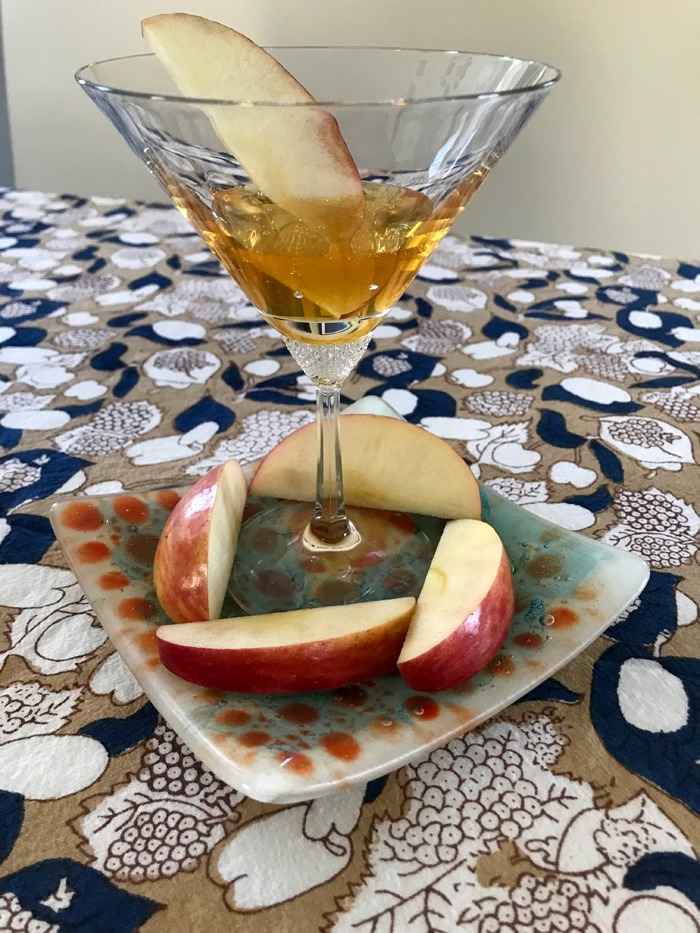
This year, sunset on Monday, September 6, marked the beginning of Rosh Hashanah, a Holy Day in the Jewish calendar that is commonly called the Jewish New Year.
It is a two-day holiday, ending at nightfall on Wednesday, September 8, that marks the beginning of the 10 Days of Awe, a time when Jews reflect, reset, and reevaluate their lives approaching Yom Kippur, the most sacred Day of Atonement.
There are several traditional observances; all are filled with rich symbolism. The central observance is the blowing of the shofar, (or ram’s horn), on both mornings of the holiday, (except on Shabbat), which is normally done in synagogue as part of the day’s services, but may be done elsewhere for those who cannot attend.
Candles are lit in the evenings to usher in the holiday with light and warmth. Since Jewish holidays begin with the setting sun, a lit candle creates a sacred space, a glimmer in a dark night.
There are other traditions, many similar to Shabbat observances, but it is the feasting that is most relevant to this column.
Food symbolizes wishes for a sweet year, blessings, and abundance and so meals focus on sweet foods.
MENU
- Apple slices dipped in honey
- Baked Fish with White Wine and Tomatoes, Leeks, and Olives
- Noodle Kugel
- Orange and Pomegranate Salad
- Honey Halvah
APPLES AND HONEY
One of the most popular and well-known customs, a meal, often begins with an apple dipped in honey and making a blessing over the apple, and adding, “May it be Your will to renew us for a good and sweet year.” Apples represent not only sweetness, but also Paradise, an auspicious sign with which to begin the New Year. Its pleasing appearance, fragrance, and taste are symbols of hope that the New Year will bring joy and success in all areas of life.
I used the last of the exquisite golden Locust Honey from Blue Ridge Apiaries in the mountains of North Carolina and a beautiful Fuji apple.
Fish dishes are traditionally a part of Rosh Hashanah. According to tradition, having fish on the table is an omen for blessings to come. When the fish is served, observant Jews recite a prayer expressing the wish, “that we be fruitful and multiply like fish.”
From an Israeli newspaper, the recipe comes from the Israeli restaurant, Pescado’s chef, Yehi Zino. I adapted it by using jarred peppers since I didn’t have fresh red chilis and adding olives and leeks which are associated with the Exodus from Egypt and made it more accessible to the home cook.
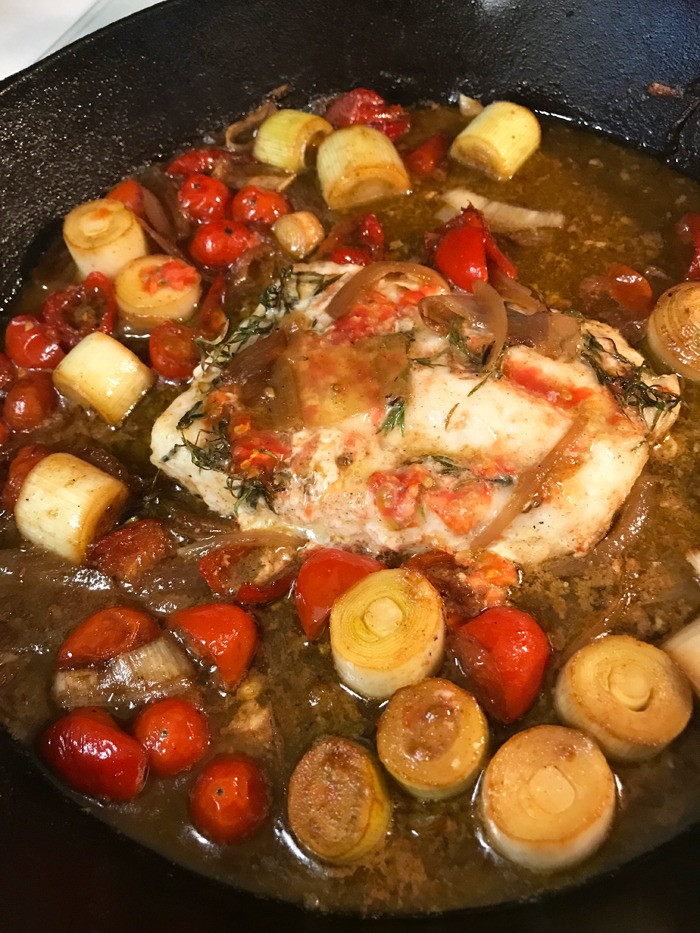
BAKED FISH WITH WHITE WINE AND TOMATOES
1 pound white fish (in this case, tilefish)
3 shallots, peeled
2 leeks
6 Castelvatrano olives, pitted and halved
5 ounces dry white wine
2 ripe tomatoes
10 whole cherry tomatoes
6 Sweet and Spicy Juanita Piquante peppers, halved
1 small sprig of tarragon (or 1 star anise)
Ground black pepper
Kosher salt
Ground dried chilis (I used Guajillo, milder and more flavorful than cayenne)
1/2 cup water
Olive oil (basil oil)
- Pre-heat oven to 350F
- Heat a cast iron skillet, slice the scallions width-wise, sear them in the skillet, and then set aside.
- Place the scallions and white wine in an ovenproof pan and cook over a direct flame.
- Cut a shallow cross-hatching pattern on the surface and salt the fish with fine salt.
- Place the fish in the pan and arrange the shallots, leeks, olives, cherry tomatoes, peppers, and tarragon. Season with black pepper, salt, and dried chili. Cut the tomatoes in half, squeeze them over the fish and vegetables, and then add them to the pot.
- Put the pan on the stove and bring to a boil until the alcohol evaporates. Add the water and pour on a generous amount of olive oil.
- Place the pan in the oven and roast until the fish is cooked, about 10-20 minutes. Check for flakiness.
- Remove from oven, sprinkle basil leaves on top, and serve.
A favorite, and some would even say a necessity, on many Jewish tables is Kugel. It is a near sacred tradition for Shabbat and Rosh Hashanah. Recipes are passed through generations and, while there are variations, most families have a tried and true version that never varies. Kugels can be based on noodles or potatoes, and this one, from my friend, Crystal Blackmon of Empty Nest Studio and Gallery in Frisco, is an Apple Noodle Kugel for Rosh Hashanah.
Crystal notes: “Since apples are used for the holiday, I slice around 7 and saute them in butter or margarine with brown sugar, cinnamon, and nutmeg to taste. I then spread the mixture of top of the kugel and press down with a spoon, allowing some liquid to integrate through the apples before baking.”
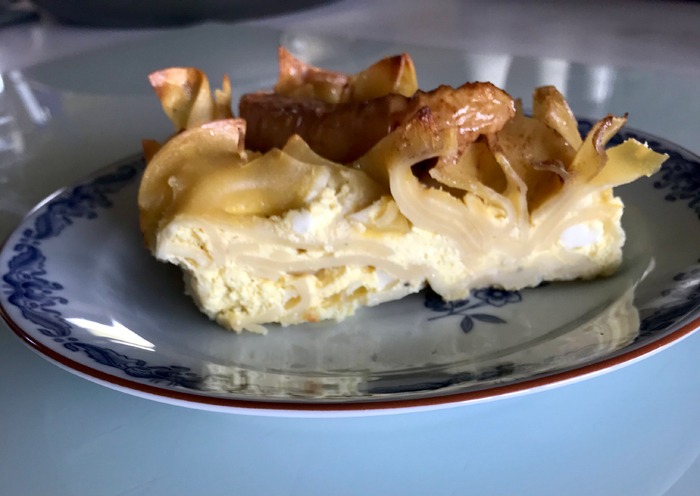
NOODLE KUGEL
8 ounces medium egg noodles
1 teaspoon lemon extract
8 ounces cottage cheese
1/2 stick butter or margarine
8 ounces sour cream
1 teaspoon vanilla extract
4 eggs
1/2 cup sugar
1/2 cup raisins
Cinnamon
Nutmeg
Brown sugar
6 or 7 apples (I used 1 large Honeycrisp apple)
- Cook noodles in water until tender, drain.
- Combine beaten eggs, melted butter, and remaining ingredients, except brown sugar and apples, in mixing bowl.
- Add noodles and mix well.
- Pour into buttered 9×13 inch baking dish.
- Top with the sauteed apples.
- Bake at 350F for 45 minutes.
- Cool and cut into squares for serving.
A bright salad adds a refreshing touch and introduces one of the most closely associated of the holiday foods. Pomegranates, with its abundant seeds, symbolize hopes we will come before God with abundant merits.
Pomegranates are said to have 613 seeds, corresponding to the 613 mitzvot, Jewish rules or commandments. The mitzvot covers many aspects of Jewish life. Jews agreed to follow these rules when they were given to Moses as part of the covenant at Mount Sinai. Following these laws is a core part of Jewish identity.
Unfortunately, I was unable to find a pomegranate, so I substituted roast beet slices for color.
The Hebrew word for beet is “selek,” similar to “remove.” It is eaten to express the hope that our enemies will depart.
Spinach is traditionally served as it symbolizes renewal. Some maintain that this leafy green is the original symbolic food for Rosh Hashanah.
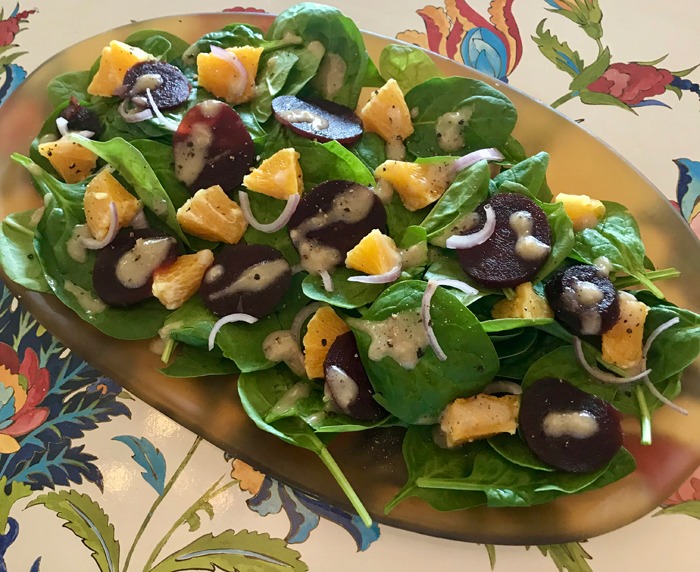
ORANGE AND POMEGRANATE SALAD
1 teaspoon honey
6 cups fresh baby spinach
salt and freshly ground black pepper
1 cup pomegranate seeds ( approximately 1 pomegranate)
2 oranges, Valencia
2 roasted red beets, sliced
1 teaspoon Dijon mustard
1/4 cup olive oil
1 1/2 tablespoons minced shallots
2 tablespoons apple cider vinegar
- Whisk together the cider vinegar, shallots, mustard, honey, and olive oil, set aside.
- Peel the oranges, removing as much of the white pith as possible, and cut into sections.
- In a large bowl, toss together the oranges, pomegranate seeds, and salad greens,
- Drizzle with the dressing and season with salt and pepper to taste. Toss gently to coat the greens with the dressing.
It is customary to finish the meal with honey cake, or apple and honey cake, but it feels too heavy for me after our feast. I chose a Middle Eastern confection that is always available in Jewish delis in the U.S. and in the markets in Israeli cities where halvah merchants pile their tables high with huge slabs of this delicacy in innumerable variations. It is rich, sweet, and sticky, but it can be stored in the fridge for quite some time so you can nibble on it a little at a time.
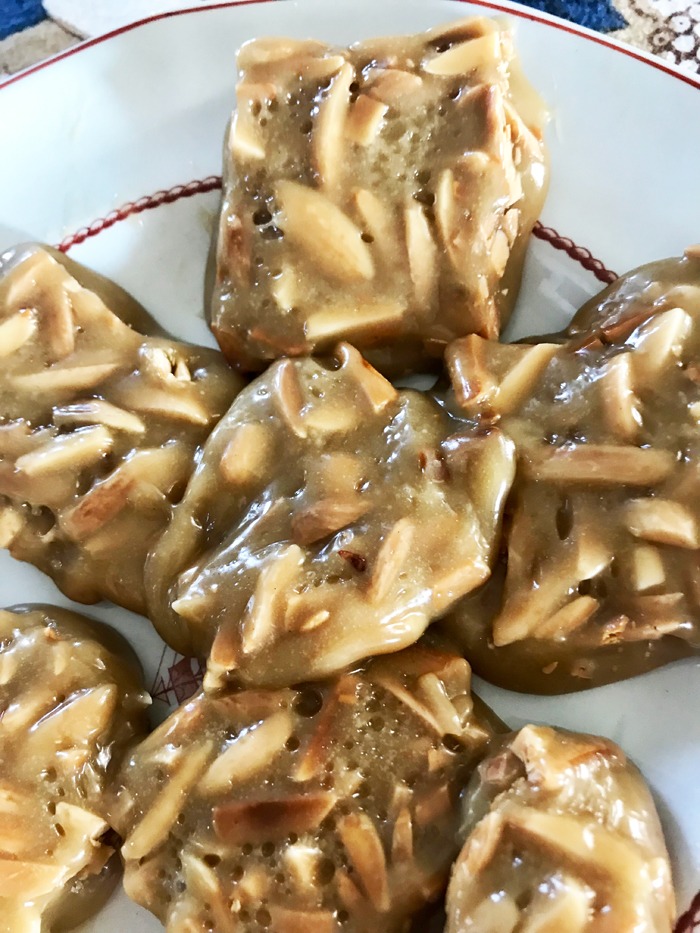
HONEY HALVAH
1 cup honey (My favorite Tupelo Honey from Lanier’s in Wewahitchka, Florida)
3/4 cup smooth tahini
1/2 cup slivered almonds
2 teaspoons rose water – you can replace with 1 teaspoon vanilla extract or 1/4 teaspoon almond extract but if you can get it, rose water gives it a genuine Middle Eastern taste.
- Add the honey to a small pot with a candy thermometer attached and place over medium heat. heat until the honey reaches 240F
- While the honey is coming up to temperature, give the tahini a good stir, making sure it is even and no oil is separating, then set aside in a second small pot.
- Once the honey reaches 240, set it aside and remove the candy thermometer, placing it in the pot with the tahini. Place over medium heat and heat the tahini until it reaches 120F.
- Pour the warmed tahini into the honey and mix well with a wooden spoon until the mixture becomes really smooth and shiny. It may take a few minutes, but eventually the mixture will come together.
- Stir in the rose water and almonds and continue stirring until it becomes fairly stiff, around 5-7 minutes.
- Pour the mixture into a loaf pan lined with parchment paper. Set it aside to cool at room temperature, then transfer to fridge for 24-36 hours. This will allow the halvah to form sugar crystals and reach the desired crumbly texture.
- Slice with a sharp knife and store and store any leftovers in the fridge.
While these are special recipes for the Jewish Holy Day of Rosh Hashanah, they can certainly be enjoyed by everyone! And it won’t hurt to think about the symbolism behind them!
"traditional" - Google News
September 07, 2021 at 09:55PM
https://ift.tt/3l0HM0L
Island Cooking: Traditional Foods for Rosh Hashanah - Island Free Press
"traditional" - Google News
https://ift.tt/36u1SIt
Shoes Man Tutorial
Pos News Update
Meme Update
Korean Entertainment News
Japan News Update
Bagikan Berita Ini














0 Response to "Island Cooking: Traditional Foods for Rosh Hashanah - Island Free Press"
Post a Comment